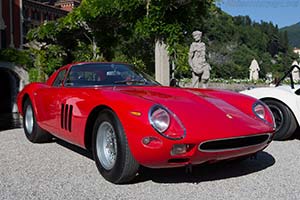
| Ferrari 250 GTO Pininfarina Coupe |
| Article | Image gallery (103) | Chassis (4) | Specifications |

|
|
<< Prev Page 2 of 3 Next >> A hot subject for debate still remains within the design of the car, but it is safe to say that not one singular person or company is completely responsible. In charge of the Comp/62 program was Gestione Sportiva's Giotto Bizzarrini. When the first test mule arrived at the track, the nose already resembled the final product, but the rear still shared styling with the 1960/61 250 GT. Designed as a race car, the body was draped as tightly over the chassis as possible. Purpose took priority over aesthetics, but fortunately beauty prevailed. Throughout the winter, the rough body was developed into its eventual shape. It was then shipped to Scaglietti, who refined the design and made it production ready. The car was first shown to the press in February 1962, but this again was not yet the final shape. During high speed testing the rear end proved to be unstable; a similar problem that dogged the Sperimentale model at Le Mans. A small lip was bolted on the 'Kamm' shaped tail, greatly improving the high speed characteristics. This device was pioneered the previous season on a V6 engined prototype by American engineer-turned-racing-driver Richie Ginther. The first 18 cars built were fitted with a separately bolted on lip, but was designed directly into the body of the remaining cars. With exception to several minute design improvements that followed, the final Comp/62 was complete. From 250 GT Comp/62 to 250 GTO The newly unveiled Comp/62 was quickly met with criticism from competitors and journalists around the world. They couldn't believe that the new racer derived from the 1961 model, but instead were convinced it was a new car. Some called it a 'Testa Rossa with a roof'. Ferrari however, were confident with the legality of the new car. Every change was approved of separately, which should make homologation a small formality. Both parties were somewhat right; the Comp/62 was so different from the previous design that it could easily be considered a new car, but Ferrari's careful planning paid off with the awarded homologation. In a similar situation both the Jaguar E-Type Lightweight and Aston Martin DB4 GT Zagato were homologated, despite the rather large departure from their original road car designs. The 250's eventual name was also consequent to this much written about process of homologation. In all official paperwork it was referred to as 250 GT Comp/62, but possibly due to a mix-up, it was generally referred to as 250 GTO; the O being short for 'Omologato' (Italian for homologation). Interestingly this name was first used in English publications, long before it reached Italy. The name stuck and by 1966 it was so synonymous with performance that GM's Pontiac division used it for their latest muscle car. Ferrari also revived the name two decades later, when they launched the competition oriented 288 GTO. GTO summary All GTOs have contemporary racing history and would require numerous paragraphs to describe each career in detail. Resulting from the walk-out in 1961 by many key personnel including Bizzarinni, the development of the GTO slowed considerably. Under the leadership of Mauro Forghieri, development continued but the new car was short of being ready for the season opening race. An 'old' 250 GT SWB defended Ferrari's honour in its place. Sebring was home to the second round of the championship where the GTO made its debut and easily won the GT-class in the hands of Phil Hill and Olivier Gendebien. It continued to win its class in every round of the world championship, including a clean sweep of the class podium at Le Mans. Ferrari won the season championship with a maximum score of 45 points, followed by Jaguar and Chevrolet. In 1963 the competition was stronger, with the introduction of the Ford-powered AC Cobras, but the GTO's success continued. Another class win at Le Mans, an outright victory in the Tour de France and the World Championship highlighted the long list of successes for the 250 GTOs that were raced by the works team and the numerous privateers. << Prev Page 2 of 3 Next >> |
| Article | Image gallery (103) | Chassis (4) | Specifications |
| All Cars - Contact us - Privacy Statement - Top | © 1998 - 2024 Ultimatecarpage.com |

